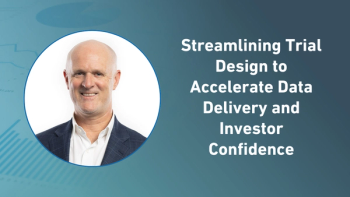
- Applied Clinical Trials-06-01-2014
- Volume 23
- Issue 6
Engaging Tomorrow's Volunteers Through Museum Learning
Science exhibit will give children and young adults a rare look inside clinical trial patient experience.
During the past decade, efforts to provide outreach and education to inform patients and the public about the clinical research process have largely overlooked a critical community: children and young adults. This community represents our future study volunteers and they hold the key to improving and establishing more sustainable levels of engagement and partnership with study volunteers and the public.
National and international polls conducted by the Center for Information and Study on Clinical Research Participation (CISCRP) and other organizations document low level of awareness and public support for clinical research. This problem is particularly acute among elementary through high-school-aged children. In a 2014 CISCRP survey among several hundred 15-18 year olds, 83% indicated that they have little to no general knowledge about clinical research. This compares with 47% of adults who gave similar ratings of their general knowledge.
Studies have not been conducted among elementary through middle-school-aged children to assess their general knowledge. Anecdotally, however, clinical research professionals with youngsters in this age group will widely acknowledge that their children know little to nothing about clinical research and what their parents do for a living.
Educating children and young adults
There are a few isolated examples of educational materials developed for children participating in specific pediatric studies. Pamphlets, brochures, storybooks, videos, board games, and applications on handheld devices have all been used to limited success for a number of reasons: Children have a short attention span; the material is not integrated or reinforced into broader learning programs; and there is no continuity once the material has been reviewed.
Extensive research in peer-reviewed literature indicates that museum learning is the most effective approach to educating children and young adults because it mirrors the natural learning process. Museum learning is experiential, exploratory, interactive, and hands-on. It presents information and problems to be solved in mixed media formats that are fun and entertaining.
Research has also shown that museums are extremely reliable and trustworthy. And they have remarkable reach. Last year alone, museums in the U.S. received more than 850 million visitors—more than the total number of visits to all sporting events (including the Super Bowl and World Series) and theme parks combined.
The Medical Heroes science museum
Two years ago, CISCRP, in collaboration with experts in the design of museum exhibits for children and young adults, began developing educational content and design elements for a new travelling science museum exhibit that will present the clinical research process through the eyes of study volunteers who gave the gift of their participation. To our knowledge, this is the first time in our history when such an initiative has been undertaken. There are a few instances where science museum exhibits have featured clinical research as a profession. But no science museum has ever featured and recognized the clinical research volunteer. Last year, AstraZeneca, the Association of Clinical Research Organizations (ACRO), the Association of Clinical Research Professionals (ACRP), PatientsLikeMe, Pfizer, and INC Research each contributed an initial round of funding and input into the educational content elements and the exhibit design. This support was used to develop, test, and refine design and content elements.
CISCRP's plan is for the science museum exhibit to occupy a 1,000 square foot area with 10 stations offering interactivity, problem-solving, and experiential learning. The museum exhibit will travel to 12 cities over the course of three years. In that time, the science museum exhibit will receive local and national media attention and support from the local clinical research community.
The Medical Heroes science museum exhibit will present authentic and balanced stories and voices of clinical research volunteers who have participated in—or are currently enrolled in—clinical trials spanning pharmaceuticals, gene therapy, medical devices and procedures, behavioral intervention, and observational studies. These encounters will give the exhibit authenticity, credibility, and emotional resonance as museum visitors connect with clinical research volunteers describing their actual experiences and the decisions and situations that led to their participation.
Two primary and powerful messages are central to the science museum exhibit: (1) Study volunteers play a critical and essential role as partners in the clinical research process helping to advance public heath and medical knowledge; and (2) each one of us may face the decision to participate at some point in our lives and it is important to know the facts and to make informed decisions.
To support these two messages, the exhibit will focus on four main areas:
- Meeting real study volunteers through photos, quotes, videos, and social media dialogue, and occasionally in person.
- Being a volunteer through making decisions about participation and through participating in a simple clinical trial.
- Learning about the impact of participation through presentations connecting well-known and relevant medical interventions with the people who gave the gift of participation to bring those interventions to market.
- Recognizing and appreciating participation.
Specifically, as children and their families move from station to station through the exhibit, they will hear and observe real study volunteer stories and experiences—both positive and negative—and what it means to be a partner in a clinical trial. Children will also hear about the risks and benefits of participation and one's rights as a volunteer; the many people that are part of the clinical trial team, including site and ethical review personnel; familiar medical innovations (eg., asthma inhalers); and the many people who participated in trials that have brought well-known and age-relevant innovations to market.
Visitors will be able to participate in an actual clinical trial—by doing a physical or mental exercise and wearing a mobile health device or completing an electronic diary—and they'll see their data compared to a benchmark. These local clinical trials will be coordinated with studies facilitated by academic research professionals in the area; a directory of local clinical research places and faces will be provided. In addition, visitors will have a chance to send thank you notes and words of appreciation electronically to study volunteers that will be posted on websites and local bulletin boards.
Impact now and in the future
The impact of this initiative is compelling and profound. Based on statistics from the American Alliance of Museums, CISCRP estimates that the 12-city tour has the potential to attract up to 1.1 million visitors. Children, young adults, and their families will influence others, including their grandparents, other family members, and friends.
An estimated 20 million people will be reached through local media coverage and through promotion and visibility as a result of coordinating the science museum exhibit with local research centers, health officials, and with health and science curricula in the school systems. National and international media coverage and social media outreach will provide substantial exposure, reaching many magnitudes more.
Success will be seen and measured on many levels—higher levels of general awareness and knowledge, ongoing integration into school curricula and educational programs, increasing public support, and higher levels of patient participation in and support for clinical research.
Stakeholder support
To succeed, this initiative requires commitment and coordination among all stakeholders in the clinical research enterprise. To that end, in April, CISCRP met with a variety of additional stakeholders to unveil and discuss the draft design element. Included were representatives from FDA; the National Institutes of Health (NIH); the National Health Council; Pharmaceutical Research and Manufacturer's Association (PhRMA); the Society of Women's Health Research; and Patient Centered Outcomes Research Institute (PCORI). CISCRP hopes to work with a broad collective of stakeholders to solicit input and leverage the knowledge, contacts, and support of its members. In the coming months, CISCRP will be meeting with individual companies to solicit their support.
CISCRP and this collaborative community are currently refining the exhibit elements, identifying and selecting science museums. CISCRP will soon begin producing and programming exhibit stations as it gears up to launch in its first city.
The Medical Heroes exhibit will lay a foundation and establish a legacy for an extensive and effective national communication and education effort. Clinical research participants will have an unusual opportunity to see their contributions showcased and appreciated, and families, teens, and adults will take away a newfound awareness of the clinical trials process and a deeper appreciation for the contributions of study volunteers. Ultimately, this legacy of education and outreach targeting children through high-school-aged adults and their families will help establish stronger levels of commitment, pride, and support for the success of the clinical research enterprise.
Kenneth A. Getz, MBA, is the Director of Sponsored Research at the Tufts CSDD and Chairman of CISCRP, both in Boston, MA, e-mail:
Articles in this issue
over 11 years ago
Three-Pronged Approach to Optimizing Trial Monitoringover 11 years ago
Half of All Drugs Today are Developed Through Collaborationsover 11 years ago
Event Examines Key Clinical Trial Adaptation Trendsover 11 years ago
Policymakers Seek New Ways to Streamline R&D and Approvalover 11 years ago
Rebranding 'Risk-Based Monitoring'over 11 years ago
Questions and Hopes on New EU Drug Legislationover 11 years ago
ACT coverover 11 years ago
The Metrics Behind High Performing Study Startupsover 11 years ago
Enhancing Trial Enrollment Through 'Goal Programming'over 11 years ago
Shifting Monitoring Paradigms: Challenges and OpportunitiesNewsletter
Stay current in clinical research with Applied Clinical Trials, providing expert insights, regulatory updates, and practical strategies for successful clinical trial design and execution.






.png)



.png)



.png)
.png)
